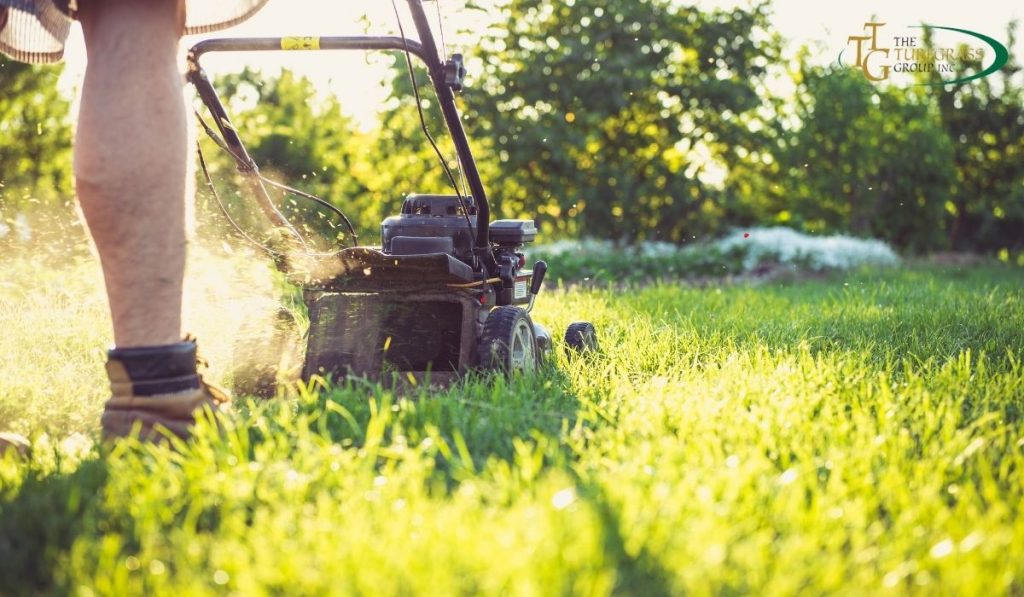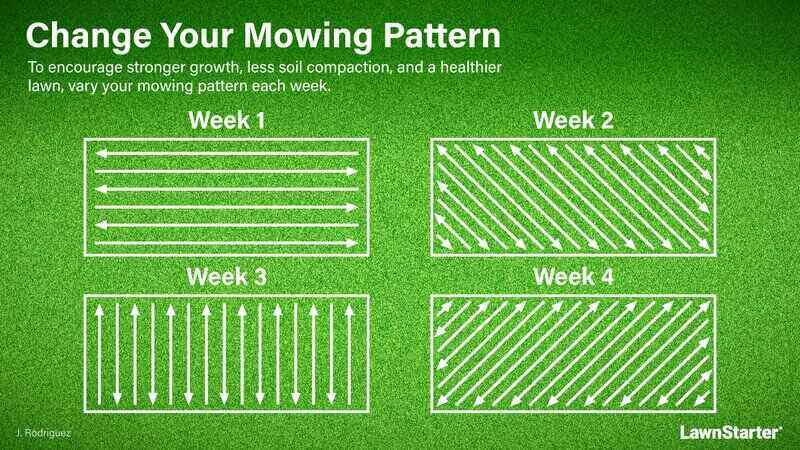Are you tired of spending hours mowing your lawn, only to feel like the results aren’t worth the effort? You’re not alone.
Many people struggle to find the best way to mow their lawn efficiently, saving time and energy while achieving that perfect, manicured look. But what if there was a way to make this task simpler, faster, and more satisfying? Imagine transforming your mowing routine into a streamlined process that leaves your lawn looking immaculate.
In this guide, you’ll discover practical tips and tricks that can revolutionize the way you mow, making it more efficient than ever before. Ready to unlock the secrets to a flawless lawn with minimal effort? Keep reading, because the solution is just a few scrolls away.

Credit: theturfgrassgroup.com
Quick Navigation
Preparing Your Lawn
Preparing your lawn before mowing ensures a smooth and efficient process. It helps you achieve the best results without unnecessary hassle. A well-prepared lawn sets the stage for an even cut. This initial step can save time and effort in the long run.
Assessing Lawn Condition
Begin by checking the lawn’s current state. Look for uneven areas or debris. Rocks, sticks, or other objects can damage the mower. Remove them to avoid accidents. Check the grass height and density. This helps determine the right mowing strategy. Healthy, even grass makes mowing easier and more efficient.
Gathering Necessary Tools
Collect all the tools needed before starting. A well-maintained mower is essential. Check the blade sharpness. Dull blades tear grass, causing stress. Also, ensure the fuel and oil levels are adequate. Keep a rake and a broom handy. These help clear clippings and debris post-mowing. A small trash bag is useful for collecting waste.

Credit: www.humboldt.ca
Choosing The Right Mower
Mowing your lawn can be a breeze with the right equipment. Selecting the perfect mower ensures efficiency and ease. With several options available, it’s crucial to choose wisely.
Types Of Lawn Mowers
Push mowers are simple and affordable. Ideal for small yards. Electric mowers run quietly and need little maintenance. Great for eco-friendly mowing. Gas mowers offer power and speed. Suitable for large lawns. Riding mowers provide comfort and efficiency. Best for sprawling areas.
Mower Features To Consider
Look for adjustable cutting heights. This helps with different grass types. Consider the mower’s weight. Lightweight models are easier to handle. Check for easy start options. Electric start saves time and effort. Examine the deck size. Larger decks cover more ground quickly.
Optimal Mowing Techniques
Efficient lawn mowing involves mowing in different directions to prevent grass leaning. Keep blades sharp for clean cuts. Adjust mower height to suit grass type and season. Mow during cooler parts of the day for best results. Regularly change mowing patterns to promote healthy grass growth.
Mowing your lawn efficiently not only saves you time but also enhances the health of your grass. Understanding optimal mowing techniques can transform a daunting chore into a rewarding task. By employing strategic methods, you’ll achieve a lush, well-manicured lawn that could be the envy of your neighborhood.Mowing Patterns For Efficiency
One of the secrets to efficient mowing is mastering your mowing pattern. Have you ever considered alternating your mowing direction each time you mow? This simple trick prevents grass from leaning in one direction and helps achieve an even cut.Try mowing in a diagonal pattern one week and a straight pattern the next. This variation not only keeps your lawn looking fresh but also minimizes soil compaction from the mower’s wheels.Another efficient pattern is the spiral method. Start from the outer edges of your lawn and work your way inward. This reduces the number of turns you make, saving time and energy.Adjusting Mower Height
Adjusting your mower’s height is crucial for the health of your lawn. Are you cutting your grass too short? It may seem efficient, but cutting too low can stress the grass and encourage weeds.Set your mower height based on the type of grass you have. For instance, cool-season grasses like fescue thrive when cut between 2.5 to 4 inches. In contrast, warm-season grasses such as Bermuda do well at about 1 to 2 inches.Consider the season, too. During hot, dry periods, allow your grass to grow a bit longer. This provides shade for the soil and conserves moisture. Experiment with different heights and observe how your lawn responds, adjusting as necessary to find the sweet spot for your unique lawn conditions.Timing Your Mowing
Timing your mowing isn’t just about grabbing the mower and going at it. It’s a strategic choice that can affect the health and appearance of your lawn. You might have noticed that your grass sometimes looks less vibrant after mowing, or perhaps it grows back unevenly. This often ties back to timing. Mowing at the right time can give your lawn the best chance to thrive, ensuring every blade stands tall and green. But how do you know when the right time is?
Ideal Mowing Times
Early morning isn’t ideal for mowing. Your grass is still wet with dew, making it prone to damage. Plus, cutting wet grass can clog your mower. Instead, aim for mid-morning, around 8-10 AM. By this time, the grass has dried a bit, but the sun isn’t too intense.
Alternatively, late afternoon can be perfect. Around 4-6 PM, the sun starts to cool down, giving your grass time to recover overnight. This timing helps avoid stress on your lawn and keeps it lush.
Have you ever mowed in the middle of a hot day and noticed your grass looking scorched? That’s because the intense sun can harm freshly cut blades, leaving them vulnerable to drying out.
Weather Considerations
Weather plays a crucial role in determining the best time to mow. If rain is forecasted, consider mowing a day earlier. Wet grass can lead to uneven cuts and clumping, not to mention the mess it creates.
Is the weather particularly windy? Wind can scatter clippings all over, making your lawn look messy. It’s best to wait for calmer conditions.
During a heatwave, your grass is already stressed. Mowing then can damage it further. Waiting until cooler days can help keep your lawn healthy.
Can you recall mowing during a light drizzle only to see your lawn look patchy afterward? That’s a common outcome of mowing during unsuitable weather.
By timing your mowing with weather conditions, you can ensure a cleaner, more efficient cut, keeping your lawn in its best shape.
Maintaining Your Mower
Efficient lawn mowing requires a well-maintained mower. Regular upkeep extends its life. It ensures smooth, hassle-free operation. Proper maintenance saves time and effort in the long run. Keep your mower in top condition with these essential tasks.
Regular Maintenance Tasks
Check the oil level before each use. Replace it as needed. Clean the air filter frequently. A clean filter helps the engine run smoothly. Sharpen the blades every season. Sharp blades cut grass evenly. Inspect the spark plug yearly. Replace it if it’s worn out.
Keep the mower deck clean. Remove grass clippings after each mow. This prevents rust and buildup. Lubricate moving parts monthly. This reduces friction and wear. Store your mower in a dry place. It prevents moisture damage. Follow these tasks for optimal mower performance.
Troubleshooting Common Issues
Engine won’t start? Check the fuel level first. Ensure fresh fuel is used. Inspect the spark plug. Clean or replace if needed. Mower sputtering? It might be a clogged air filter. Clean or replace it. Check the fuel line for blockages.
Uneven cuts? The blade could be dull. Sharpen it for a better cut. Mower vibrates? Tighten any loose bolts or screws. Inspect the blade for damage. These solutions address common mower issues. Regular checks help maintain efficiency.
Safety Measures
Ensure safety by wearing protective gear like gloves and goggles while mowing. Keep children and pets away to prevent accidents. Always check for debris before starting to mow.
Mowing your lawn efficiently is not just about getting the job done quickly. It’s also about doing it safely. Whether you’re a seasoned gardener or a newbie, understanding safety measures can save you from accidents and ensure your lawn looks great. Imagine being able to mow without worrying about injuries or damages. That’s possible if you prioritize safety. Below, you’ll find essential safety tips that you can easily follow.Personal Protective Equipment
Before starting the mower, gear up! Wearing personal protective equipment (PPE) is crucial. Think of it as your safety armor.A sturdy pair of shoes can protect your feet from sharp objects. Flip-flops or sandals are a big no-no.Safety glasses shield your eyes from debris. You’d be surprised how fast things fly off when you’re mowing!Don’t forget ear protection. Mowers can be loud, and prolonged exposure can harm your hearing.Gloves give you better grip and protect your hands from blisters. They also guard against unexpected cuts.Why risk injury when a few extra minutes can keep you safe?Safe Operating Practices
Operating your mower safely involves more than just pushing it around. It’s about being mindful of your surroundings and the machine itself.Start by clearing the area of toys, rocks, or any debris. These can become dangerous projectiles.Always mow across slopes, never up and down. This prevents the mower from tipping over.Keep children and pets away from the mowing area. Curious little ones and pets can quickly wander into danger zones.Avoid mowing wet grass. Slippery conditions can lead to loss of control and accidents.Lastly, never unclog the mower while it’s running. Turn it off, and use a stick or tool to clear the blockage.These practices ensure you mow safely and efficiently. How often do you check your mower before starting? Is there room for improvement in your routine?Post-mowing Care
Post-mowing care keeps your lawn healthy and green. Remove grass clippings to prevent choking the grass. Water your lawn evenly to promote growth and resilience.
After mowing your lawn, the job isn’t quite done yet. Post-mowing care is vital to ensure your lawn remains healthy and vibrant. Think of it as the cool down after a workout. By dedicating a few extra minutes, you can enhance the look and health of your turf, making all the effort worthwhile.Cleaning Up Clippings
Leaving grass clippings scattered can make your lawn look untidy. Collect them to prevent clumping, which can block sunlight and air from reaching the grass below.Consider using a rake or a lawn sweeper to gather clippings efficiently. If your mower has a bag attachment, even better—save yourself time by collecting clippings as you mow.Alternatively, using clippings as mulch can be beneficial. Spread them evenly to return nutrients to the soil. Ever notice how fresh clippings seem to disappear? That’s nature working its magic, breaking them down to nourish your lawn.Lawn Health Monitoring
Monitoring the health of your lawn after mowing is crucial. Look for signs of stress like brown patches or weeds trying to make a comeback.Regularly inspect your lawn to catch problems early. A healthy lawn should have consistent color and thickness. If your grass looks uneven, it might need extra care or nutrients.Check for pests or diseases. Sometimes, mowing can stir up hidden issues. By keeping an eye out, you can address these promptly before they escalate.Taking these steps post-mowing helps maintain your lawn’s vitality. How do you ensure your lawn stays lush and green?
Credit: www.npr.org
Conclusion
Mowing your lawn efficiently saves time and effort. Start with a plan. Keep your mower blades sharp. Cut grass when it’s dry. Avoid cutting too short. This protects the roots. Mow in different directions each time. It helps grass grow better.
Regular mowing keeps the lawn healthy. Clean your mower after use. It extends the machine’s life. Enjoy your green, well-maintained yard. Happy mowing!